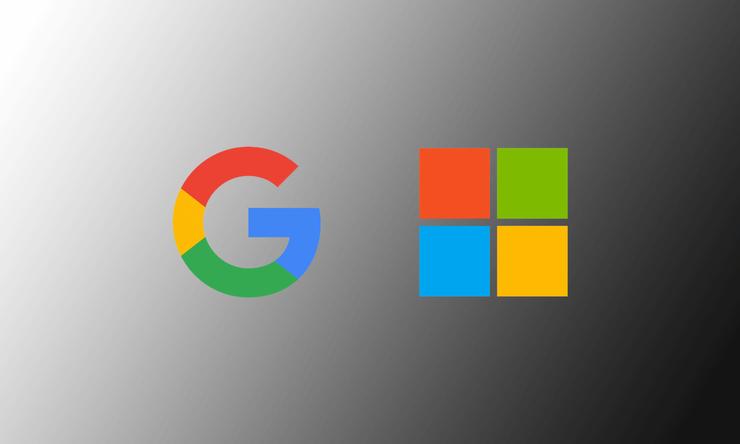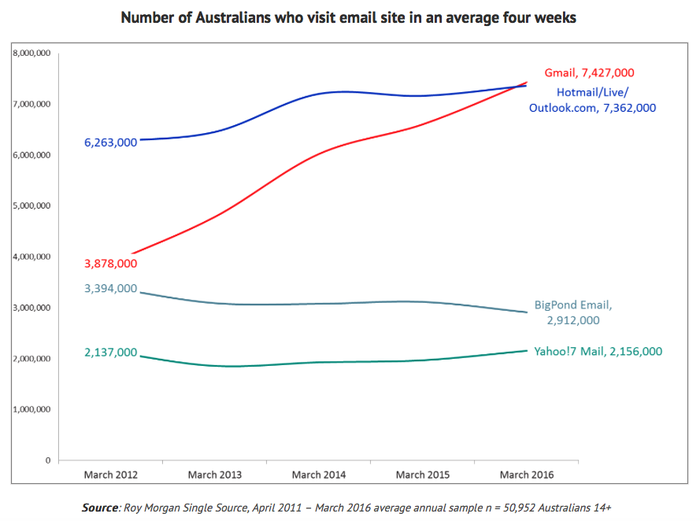 Credit: Supplied
Credit: Supplied
Gmail has recently surpassed Outlook to become Australia’s most-used email service, with Google overtaking Microsoft for the first time across the country.
Findings from Roy Morgan Research shows that 7.4 million Australians aged 14 and above (37.9 per cent) used Gmail in an average four weeks in the 12 months to March 2016, exceeding the 7.3 million emailing through a Microsoft account (37.6 per cent).
“The change in lead has been a long time coming,” Roy Morgan Research CEO, Michele Levine, said.
Levine said that since 2012, Gmail has claimed over 3.5 million new Australian users, averaging almost 900,000 new emailers annually and almost doubling its user base.
Meanwhile, Outlook.com has gained 1.1 million more active users over the period, with the bulk of growth in just the year following the transition to Outlook.com in early 2013, after which the number of users has remained fairly steady.
In distant third is Telstra’s BigPond Email, with 2.9 million Australians (14.9 per cent) visiting the site in an average four weeks, down from 3.3 million in 2012.
After losing some emailers in the 12 months to March 2013, Yahoo!7 Mail has since regained an average of close to 100,000 emailers annually, and now has 2.1 million users (11.0 per cent) - back above its base in 2012.
Overall, Levine said 14.3 million Australians aged 14 and above (73 per cent) now use one or more of these email services.

“Nearly three quarters of Australians use one (or more) of these big four email services in an average four weeks,” Levine added.
“Free email accounts are mostly advertising-supported. The fine print of signing up is that email content is analysed by automated systems.
“Many of us have experienced seeing search results or digital advertising that reflect something we’d mentioned in a recent email.”
Although nearly 70 per cent of Australians remain worried about invasion of privacy through new technologies, Levine said users take advantage of free email services knowing that personal emails will be “read” and advertising will be customised and tailored.
“Done well, this can work for both the advertisers, who want to target more accurately and cost-effectively, and users, who would prefer search results and ads are relevant,” Levine added.
Enterprise traction
But while Google takes a slight lead in terms of overall usage in Australia, recent findings from Gartner reports that Microsoft dominates cloud email in large public companies, as cloud email continues to gain traction among enterprises worldwide.
Despite the cloud email market still experiencing the early stages of adoption, 13 percent of identified publicly listed companies globally are now using one of the two main cloud email vendors - Google or Microsoft.
As a result, Gartner found that 8.5 percent of public companies in the sample use cloud email from Microsoft's Office 365 service, while 4.7 percent use Google Apps for Work, with the remaining 87 percent of companies using on-premises, hybrid, hosted or private cloud email managed by smaller vendors.
These are the findings of a Gartner research study based on an automated examination of a large number of publicly available email routing records.
Gartner used the email server addresses in the domain records of nearly 40,000 public companies globally, to find out which ones point to cloud email services from Google or Microsoft.
“Although it is still early days for cloud email adoption, both Microsoft and Google have achieved significant traction among enterprises of different sizes, industries and geographies,” Gartner Research Vice President, Nikos Drakos, added.
“Companies considering cloud email should question assumptions that public cloud email is not appropriate in their region, size or industry.
“Our findings suggest that many varied organisations are already using cloud email, and the number is growing rapidly.”

Among organisations using cloud email from Google and Microsoft, Microsoft is ahead in most industries, particularly in regulated industries including utilities, energy and aerospace.
Google is ahead in industry segments with more competition and less regulation, such as software publishing, retail, advertising, media, education, consumer products, food and beverage, and travel.
Closer to home, Microsoft is stronger in all regions, including Australia, while Google is more prevalent in Asia.
“Among public companies using cloud-based email, Microsoft is more popular with larger organisations and has more than an 80 percent share of companies using cloud email with revenue above $10 billion,” Gartner Research Vice President, Jeffrey Mann, added.
“Google's popularity is better among smaller companies, approaching a 50 percent share of companies with revenue less than $US50 million.”
In some industries - such as travel and hospitality, professional services and consumer products - the highest usage levels are among the companies with the biggest revenue.
More than a third of companies in these industries with revenue above $US10 billion use cloud email from one of these two vendors.




